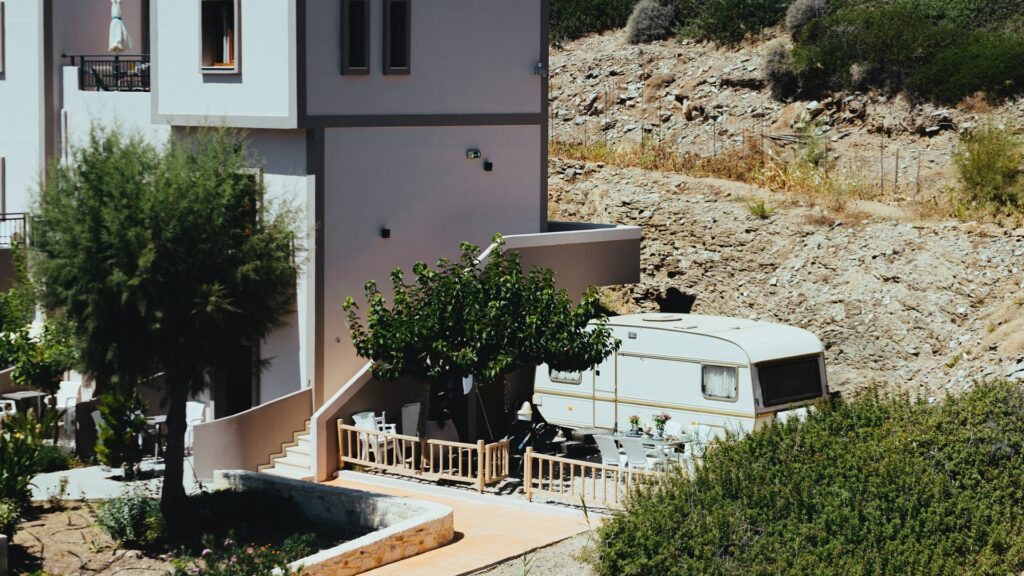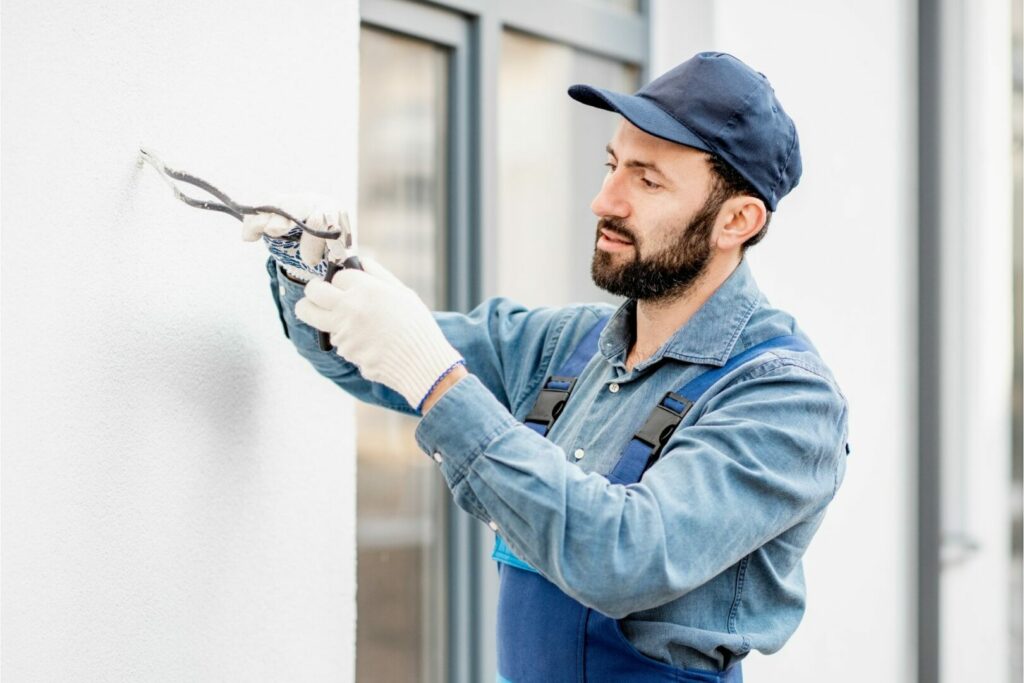Table of Contents Show
Most RVs, particularly smaller motorhomes, travel trailers, and fifth wheels, use a 30-amp RV plug. That means you’ll need a 30-amp outlet at home to fully power your RV when it’s parked there.
Unfortunately, most homes aren’t set up for this. But on the bright side, safely installing a 30-amp RV outlet isn’t complicated. A handy do-it-yourselfer with some basic knowledge of electricity can do the install. If you’re inexperienced with electricity or concerned about doing the job, consider hiring a professional.
First, let’s learn what you need and how to install a 30-amp RV plug at home. Then you can decide if you’re confident enough to do it yourself.

Can You Connect Your RV to Your Home Without a 30-Amp RV Plug?
You can connect your RV to your home’s power without a 30-amp RV plug, but it will limit which and how many appliances you can operate. A typical 120V home outlet is on a 15-amp or 20-amp breaker. This means you’re operating with about half the power you’d get when plugged into a 30-amp outlet.
Many of the appliances in a 30-amp powered rig will still operate, but you can’t run many things simultaneously. For example, if you have the coffee pot on, you can’t safely operate the air conditioner, heater, or microwave at the same time.
To connect, use a 30-amp to 15/20-amp adapter for your RV. Also, use an outdoor-rated extension cord that’s a heavy enough gauge (a 10-gauge should do) to handle the amperage. It should also be as short as possible. Most typical extension cords are not rated to handle the load of a 30-amp or 50-amp RV. This set-up should only be for short-term usage.
What Is the Difference Between 30 Amp & 50 Amp Plugs?
A 30-amp plug is used on smaller RVs that don’t usually power anything more than a microwave, a furnace, a single AC unit, etc. Larger motorhomes and fifth wheels with several power-hungry appliances typically use 50-amp plus. This means they can power things like dual AC units, a washer/dryer set-up, a dishwasher, and the like.
There are also physical and usage differences between a 30-amp plug and a 50-amp plug. A 30-amp plug has three pins. These are a 120-volt hot pin, a flat neutral pin, and a round ground pin. It can provide up to 3,600 watts of power.
A 50-amp plug has four pins. There are two 120-volt hot pins, a flat neutral pin, and a round ground pin. A 50-amp plug can provide up to 12,000 watts.

Pro Tip: We have everything you need to know about RV power cords right here →
How Many Volts Does a 30 Amp Service RV Take?
A typical 30-amp RV service is a single-pole service (one hot pin) that requires 120V. A 30-amp, 120V service provides 3,600W of power (30 amps x 120V = 3,600W).
Where Should You Install the 30 Amp RV Receptacle?
Install the 30-amp RV receptacle close to where you park your RV. Usually, you’ll use an RV power pedestal similar to what you see in a commercial RV park. You could use a simple 30-amp RV outlet mounted on a wall or post, but it’s a more difficult installation process.
Wherever you mount the receptacle, it must be solid. Plugging and unplugging a 30-amp RV plug puts a lot of stress on the outlet, so it needs more reinforcement than a standard household 15/20-amp outlet.
What Kind of Wire Do You Need to Install a 30 Amp Plug?
You need 10-2 or 8-2 UF wire to install a 30-amp plug. The number before the dash is the gauge of the wire. The lower the number, the thicker the wire, and the more amperage it can handle. The number after the dash is how many conductors the wire has. UF means it’s rated for outdoor usage.
Most installations (under 150-feet in length) can safely use 10-2 wire. It has a black 120V hot wire and a white neutral wire; these are the two conductors. There should also be a green ground wire.
An 8-2 wire is the same as 10-2, but it’s thicker and can handle 30 amps in runs longer than 100 feet. If your installation is less than 100 feet, use the 10-2 wire.

Pro Tip: Before you start any electrical project for your RV, make sure you know the basics of RV wiring and electrical.
What You Need For The Job
There are a few items you’ll need before tackling the installation:
- An empty space in the breaker box for a 30-amp, single-pole breaker.
- A new 30-amp, single-pole breaker. (This breaker has one handle and one terminal for the hot wire to connect.)
- Enough UF-rated 10-2 copper wire to run from the breaker box to the RV pedestal. Use 8-2 copper wire if your run is over 150 feet.
- A weatherproof RV pedestal with a 30-amp (NEMA TT-30R) outlet OR a separate weatherproof 30-amp (NEMA TT-30R) outlet for wall mounting.
- One-inch diameter conduit for the wire anywhere that it can’t be buried at least 24 inches deep, as required by code.
- Wire staples or clamps to secure the wires running to the pedestal and breaker box.
How to Install a 30 Amp RV Plug
With the appropriate supplies in hand, let’s move on to the installation process. It’s not overly complicated, but working with electricity can be dangerous. You must understand how to safely work with electricity before proceeding.
If you feel confident in your electrical skills, here’s how to DIY install a 30-amp plug at home.
Shut Off the Main Breaker
This is the crucial first step. The main breaker will either be a 100-amp or 200-amp breaker. Shut it off so there’s no power going to the other breakers or out of the breaker box.
Keep in mind there could be another breaker box somewhere that has a main breaker that feeds into this one. Find it and shut it off as well.
Even when your main breaker is disengaged, there’ll be live wires connected to the main breaker. Be careful not to touch the live wires while working at the breaker box.
Use a voltmeter or a non-contact voltage tester (which we prefer) to check the other breakers to ensure they’re dead (no power running through them). Put tape or a note over the main breaker after you turn it off so that someone else doesn’t come along and turn it back on while you’re working.
Install the Outlet Box
Mount the RV pedestal or outlet near where you plan to park your RV. Test the mounting site to make sure it’s solid, and follow the instructions that come with the kit. This is the easiest step in the installation process.
Install a New Breaker in an Empty Spot
Before installing the new breaker, double-check that the power is off. We can’t stress this enough: This is crucial any time you’ll be working at the breaker box, connecting wires, or working at the pedestal or outlet.
As mentioned, the breaker box needs to have space for a 30-amp, single-pole breaker. Install the new breaker into the empty slot, not touching the live wires connected to the main breaker terminals.
Run the Wire Through the Conduit
Run the wires through the conduit before you connect them to the breaker and the pedestal or outlet. Per code, the wire must run through a protective sleeve above ground down to 18 inches deep. Check for any variances in local code that may have stricter requirements than the national code.
As long as the wiring is rated for outdoor use, it can run without a conduit if it’s buried at least 24 inches deep. It still requires a conduit where it goes in and out of the ground.
Connect the Wires to the Breaker
Next, connect the wires to the breaker. The green ground wire connects to the ground bus and the white neutral wire connects to the neutral bus. Then, connect the black 120-volt hot wire to the terminal on the new 30-amp breaker.
Run the Cables to the Outlet Box
Once the wires are connected at the breaker box, move to the pedestal or outlet. The terminals on the back of the outlet are typically well labeled; you’ll likely find them on the pedestal or separate receptacle.
Attach the green ground wire to the terminal labeled green, which is the back of the U-shaped hole. Connect the white neutral wire to the terminal labeled white or neutral (usually a silver screw) in the 7 o’clock position from the back of the outlet. The black 120V hot wire connects to the hot terminal (usually a brass-colored screw) in the 5 o’clock position from the back of the outlet.
Switch on the Breaker & Test
It’s just about time to test your handiwork. First, we strongly suggest double-checking your work both at the breaker box and at the outlet. If in doubt, don’t turn it on until you’re sure the wiring is correct.
Once everything looks good, turn the breakers back on and plug it in. If everything is working as it should, you’re good to go!

Should You DIY or Hire a Professional for This Job?
Most folks who are handy with repairs and have a solid understanding of safely working with electricity should be able to handle this installation. But even if you’re knowledgeable, don’t let your guard down. When working with electricity, always double or even triple check your work before powering up.
If you’re hesitant about working with electricity, bring in a professional. There’s nothing wrong with letting a pro do the job.
This is also a fairly straightforward job, so it shouldn’t be overly expensive. A professional installation for a 30-amp pedestal or outlet should cost between $300 and $1,200. You can keep that cost down by installing the pedestal post, digging a trench for the conduit (if necessary), etc.
Is Installing a 30 Amp RV Plug at Home Worth It?
If you’ve got a place to park your RV at home, why not install a 30-amp plug? You can keep the batteries full, do repairs and maintenance, or even use it as a guest house.It’s an easy enough task to do yourself, but professional installation isn’t too expensive either.
Here’s another tip we’ll throw in: If you install a 30-amp outlet, it might be wise to wire a 50-amp outlet at the same time. That way, you can upgrade your rig in the future or let a friend with a 50-amp rig park there. Most pedestals have both outlets and having both wired at the same time cuts the cost of separate installation.
Either way, it’s a useful addition to your RV arsenal that could save you a lot of time and money when doing repairs or general upkeep.






